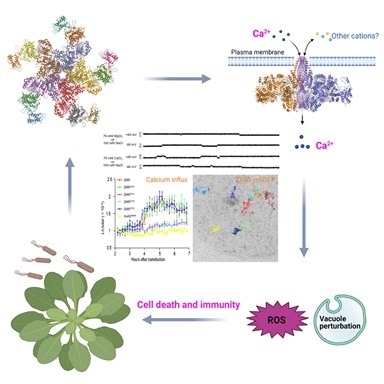Disease resistance proteins function as main immune receptors in plants, detecting pests and pathogens and initiating robust defense responses.

The ZAR1 resistosome acts as an ion channel in the plasma membrane to trigger Ca2+ ion flux and immune responses. Image Credit: Bi et al., Cell.
Scientists previously discovered that when invading pathogens are detected, one such disease-resistance protein, ZAR1, is converted into a highly organized protein complex known as resistosome, giving the first hint as to how plant disease resistance proteins function. However, it is unclear how a resistosome stimulates plant defenses.
Professors Jianmin Zhou, Yuhang Chen, and Kangmin He from the Chinese Academy of Sciences’ Institute of Genetics and Developmental Biology and Professor Jijie Chai from Tsinghua University recently used state-of-the-art electrophysiology and single-molecule imaging to study the molecular mechanism by which the ZAR1 resistosome stimulates plant immunity.
The researchers first demonstrated that the ZAR1 resistosome is a calcium-permeable, cation-selective ion channel using Xenopus oocyte and planar lipid bilayer electrophysiology experiments. They then used single-molecule imaging to demonstrate that the activated ZAR1 resistosome forms pentameric oligomers in the plant cell’s plasma membrane, supporting previous structural evidence.
The development of a ZAR1 resistosome in a plant cell causes sustained calcium ion influx and subsequent immune signaling events that lead to cell death, and both of these processes are dependent on the ion channel’s function.
These findings support the conclusion that the calcium signal activated by the ZAR1 channel creates immune activation, providing critical insights into the operation of plant immune systems.
Disease-resistant proteins are the main family of plant immune receptors, which play a critical role in agriculture by defending crop plants from a variety of pests and pathogens such as oomycetes, nematodes, insects, bacteria, viruses, fungi, and parasitic weeds.
This study’s results shed light on the exact biochemical function of certain disease resistance proteins and propose new strategies for managing disease and pest harm in crop plants.
“This work presents important findings that will change our view of ETI-triggered cell death. The use of TIRF to visualize and monitor in real-time membrane-associated resistosomes is very exciting and many researchers will strive to emulate this method,” concluded a reviewer from Cell.
Source:
Journal reference:
Bi, G., et al. (2021) The ZAR1 resistosome is a calcium-permeable channel triggering plant immune signaling. Cell. doi.org/10.1016/j.cell.2021.05.003.